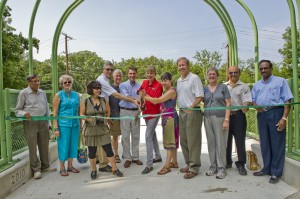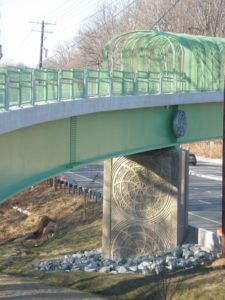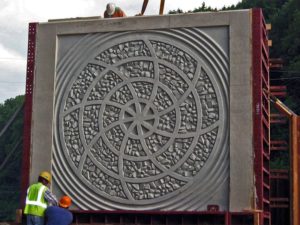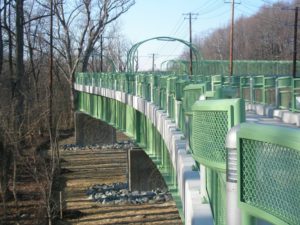If you’re new to the area you may not know that the Veirs Mill area was part of an extensive mill industry that thrived in 19th century Montgomery County. Now, public art has brought that history to life again in the Rock Creek Trail Pedestrian Bridge.
The 605-foot-long Bridge which spans Veirs Mill Road at Aspen Hill Road is an excellent example of how public art creates lively community spaces. In this day of multilane highways and strip malls, the history and soul of a place is often lost under a barrage of chain stores and restaurants. But for walkers, bicyclists and motorists near at the Rock Creek Pedestrian Bridge, over one hundred years of local history can be found and enjoyed in this beautiful bridge and the surrounding grounds. The Bridge was dedicated on July 23, 2011 with much fun and hoopla.

I asked Vicki to share how she chose the historical references seen in the Bridge. Here are her responses:
Scuri: In the early 1800s, there were numerous mills in Montgomery County with a heavy concentration in what is now the Veirs Mill area. Because of this distinctive history, I chose water and the waterwheel as a primary motif for the bridge. You can see the influence of water in the curving fencing of the pedestrian bridge. The waterwheel theme is repeated in the concrete pillars that support the bridge and again in the planter design on the south side of the bridge.


Another source of inspiration came from the Cabin John area where Victorian Washingtonians came to relax, play and enjoy the beautiful grounds around the Cabin John Hotel. The grounds included an ornate iron footbridge that epitomized Victorian Romanticism. The fencing of the Rock Creek Bridge replicates the crisscross pattern found on the Cabin John footbridge and in general harks back to that playful and romantic time in the late 19th century.

If you’d like to learn more about public art in Montgomery County then click here to see our short and snappy multimedia overview!
